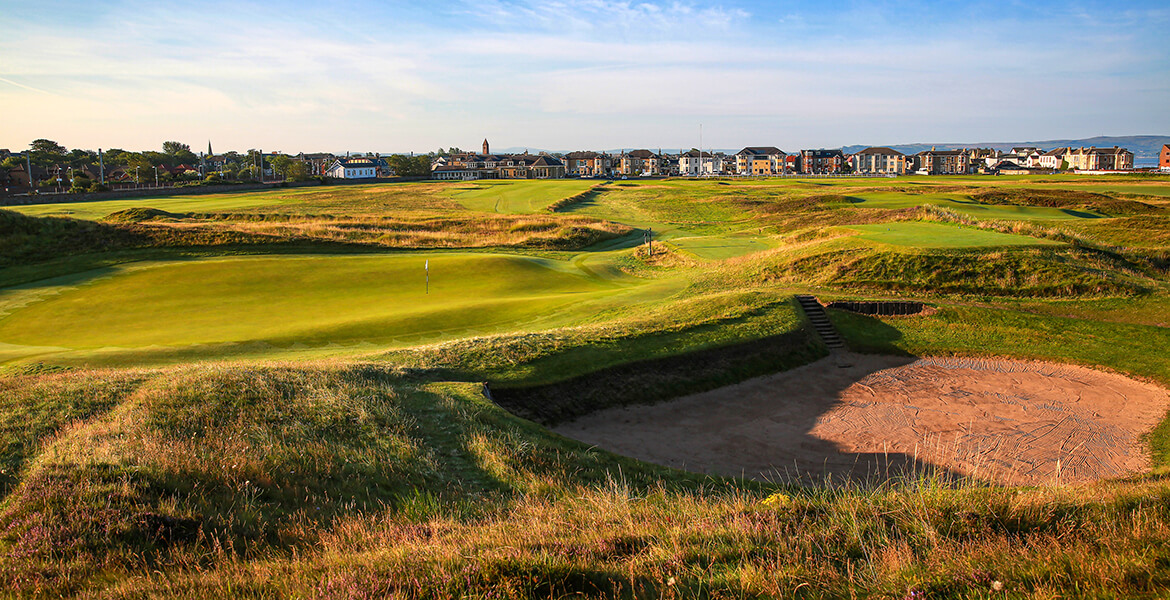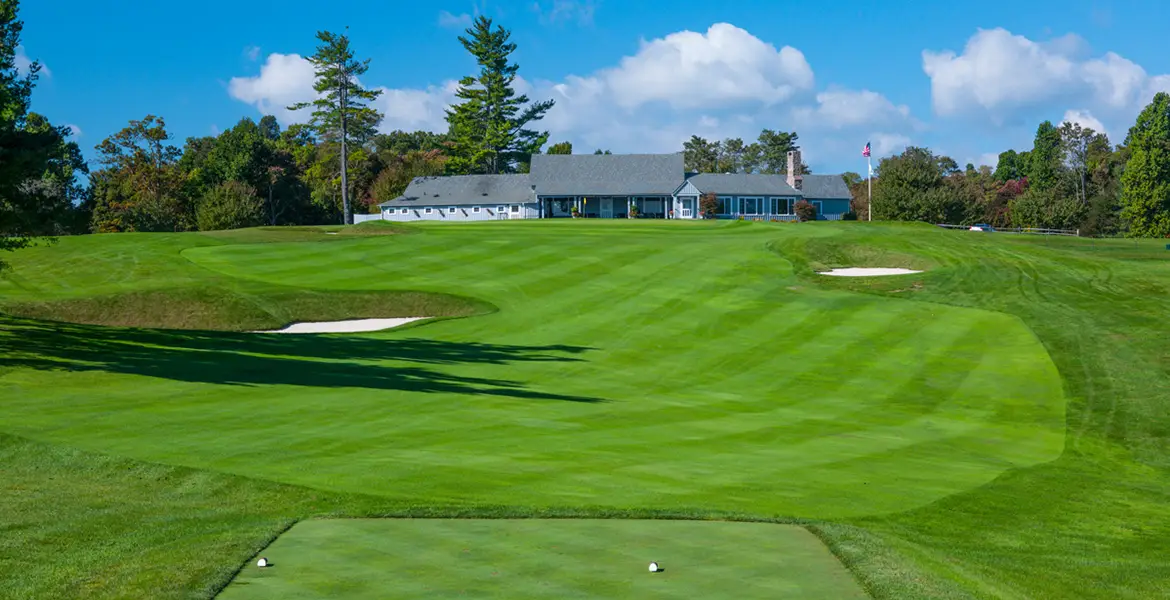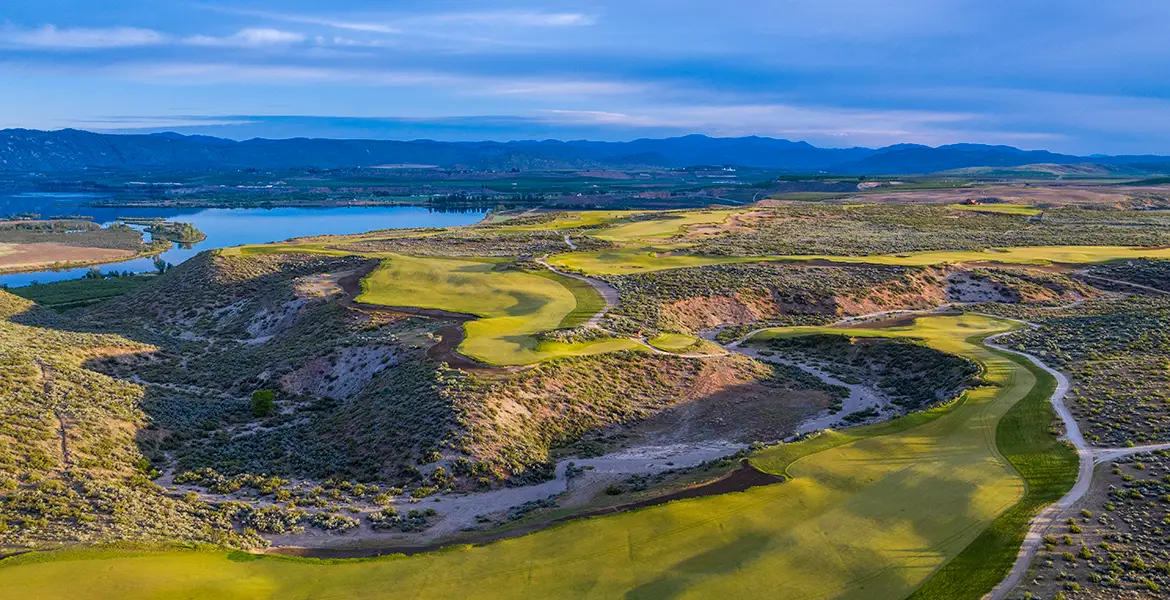The story of Prestwick Golf Club begins in 1851, when a group of friends gathered at the Red Lion Inn decided to create a golf club. Old Tom Morris was hired to be its first greenkeeper, and he competed in the first 12 Open Championships held on his then 12-hole home course, winning four times. At that time, the hole we now know as the course’s 17th played as its 2nd. But even then, the par-four hole called “Alps” was one mean, menacing monster.
The Stats
- Par four
- 372–394 yards
- Five bunkers (one of them size XXL)
- One blind shot
- Stroke Index: 6
Hole Description
“Alps” is a straight-ahead par four whose steadily rising fairway grows progressively narrower the closer you get to the jutting sandhill behind which lurks the green, which is itself protected at its front by one of golf’s largest and most famous bunkers, appropriately called “Sahara.”
What Makes It Great
Like all great par fours, “Alps” calls for two well-struck shots to yield a chance at par. If you’re wild off the tee, you’ll struggle to find the green in regulation—only partly because you won’t be able to see it. The blind second shot over the imposing sandhill creates doubt, which is the biggest enemy of any golfer. Should you under-club or mishit your second shot, you’ll have the privilege of playing from Sahara—a pit of despair from which few pars are saved.
How to Play It
When you arrive at the tee, check the sign that indicates the pin position for the day. You’ll want to correlate that information with the three markers at the crest of the Alps sandhill when playing your second shot. From the tee, you can ignore the Cardinal bunkers located just a few paces in front of you. It’s the narrow ribbon of fairway that you must focus on—a fairway that grows ever narrower the closer it gets to the base of the Alps, an area known as the “Slough of Despond.” To each side of the fairway are a series of mounds and hillocks covered with heather and tall grasses. You’ll struggle to find a flat lie amongst them—assuming that you find your ball at all. Fortunately, at 394 yards, Alps isn’t a long hole. So, unless it’s playing into the wind, you can probably get away with hitting a fairway wood or hybrid from the tee, which should increase your chances of finding the short grass.
On your second shot, determining the right yardage is the chief challenge. You absolutely cannot come up short. This task is made doubly difficult by the presence of the giant dune between you and the green. Keep in mind: The land slopes back down to the green, so even though you may feel like you’re playing an uphill shot, you’re really not. You’re just hitting over that giant hill—hopefully with no more than a mid-iron. If you have time to venture to the top of the hill and survey the shot before playing it, you should.

The green you’ll be hitting to is wide, but just 22 paces deep—and it slopes sharply from back to front. This gives you a bit of a backstop on your approach shot, but should you go long and over the green you’ll be faced with a slippery downhill chip that, executed poorly, could see you arrive in the Sahara bunker from an unlikely direction.
Sahara is seven feet deep. If you find yourself in it, you will not be able to see the putting surface as you play your recovery shot. Instead, you’ll see a wall of revetted turf staring at you with derision. The only good news is that the green is a bit of a punchbowl, so if you can play your explosion shot well enough to get it to the green, chances are it will stay on.
After putting out, be sure to ring the bell beside the green to let the group behind you know the way is clear. It’s a singular pleasure, ringing that bell. It means you’ve played a hole with a blind approach shot—something common and, by some, beloved in the world of links golf. In this case, you’ll have seen one of the most famous of them all.
Other Alps Holes
The 17th at Prestwick has often been imitated, in particular by course designer Charles Blair Macdonald, to the point that it is now regarded as a template hole. Uphill tee shot, blind second shot, bunker(s) in front of a usually punchbowl-shaped green—that’s the recipe. Some other examples of it include:
- 7th, Camargo Club, (Ohio)
- 4th, Fishers Island Club, (N.Y.)
- 3rd, National Golf Links, (N.Y.)
- 16th, Old MacDonald (Ore.)
- 18th, St. Louis Country Club (Mo.)
- 12th, Yale Golf Club, (Conn.)
Sunrise and the shadows on the 16th of Old Macdonald “Alps”. @BandonDunesGolf @renaissancegol2 @tomdoak #cbmacdonald #bandondunesgolf pic.twitter.com/iWOXkStV8K
— Evan Schiller (@Evan_Schiller) April 12, 2019
Author’s Note: This Alps hole design with its Sahara bunker is not to be confused with other holes called “Sahara” after the eponymously named 3rd hole at Royal St. George’s Golf Club. There, and at other holes mimicking it, it’s your tee shot that has to carry an exposed sandy wasteland.
Do you have a favorite “Alps” hole? Let us know in the comments.






